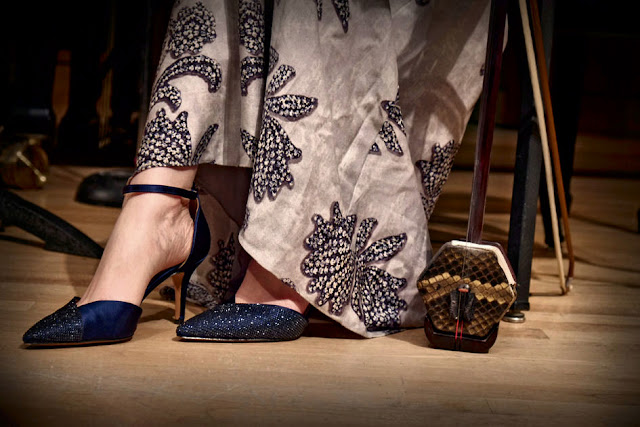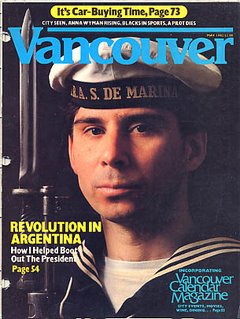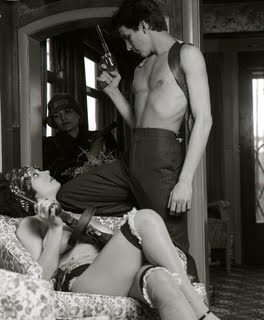Two Musical Performers With Saavy & Elegant Grace
Tuesday, February 23, 2016
 |
| Marina Hasselberg & Nicole Ge Li |
Of late with my move (finally) to our new smalish Kitsilano digs stress has been finally eased. But during the moving turmoil that included a flood in my basement (the old house) that terminated my goal of printing as much of the photographic paper that I had there were two moments of peace, relaxation and adventure. Both were musical events. One was a solo cello concert by Marina Hasselberg who featured the music of very alive and mostly very young Vancouver composers. The other was a concert by erhu player Nicole Ge Li in her Piano & Erhu Project (
PEP) with noted UBC pianist and instructor Corey Hamm.
 |
| From Left to right: Lucas Oickle, Stephen Chatman, John Oliver, Dorothy Chang, Mark Aemanini,Angelique Po,Keith Hamel and Bob Pritchard. Barnett Hall, UBC February 5, 2016 |
I have been unable to write about the experience until now because of computer problems, old phoneproblems (a dying iPhone 3G) new phone problems ( a Galaxy S5) and five days of random disappearance of email from all my platforms. At one point when I was receiving “phantom” emails in my 3G that were not there when they finally downloaded I suspected that my family and friends from the beyond were attempting to communicate with me.
 |
| Dominion Building January 15 2016 |
The two extremely unusual concerts (with all the time that I subsequently had to think about them) made me linger in concerts past. I remember the first one I ever attended.
My parents took me to the Teatro Colón in 1950 (I was 8) to a piano recital by Arthur Rubinstein. It was in the middle of the harsh and humid Buenos Aires winter. Rubinstein appeared wearing tails, bowed to us and sat down. Before he could begin there was loud coughing in the audience. He waited and when he was about to start the coughing persisted. He got up and faced us. He removed a pen (or pencil) from his front pocket and directed us to cough in unison. Coughing ceased. He then played. It was then that the audience noted that he was drunk. The Buenos Aires concertgoers showed their displeasure by showering him with coins (aimed to hit him). He left in a huff. We waited for about 30 minutes. He returned and played beautifully.
 |
| Elegance - Nicole Ge Li |
In 1965 my then my musically inclined Argentine girlfriend called Susana told me that I was a cultural aberration and that I needed some prodding in that department. She bought good seats at the Teatro Colón for an opera. The opera was a rare one called
The Fiery Angel by Sergei Prokofiev. This was during the sweltering and humid Buenos Aires summer. I had only one suit which was an American-made black wool Botany Bay. I suffered. To this day I love Prokofiev and particularly his
Romeo & Juliet when danced by Evelyn Hart.
 |
| Elegance - Marina Hasselberg |
Both Nicole Ge Li and Marina Hasselberg share the same age (around 30). Both understand the importance of image and wear spectacular clothing, shoes and sometimes (yes!) fishnets. Both understand the trap that playing a conservative and established repertoire can be and how boredom can set in.
Li plays a classic Chinese instrument called an erhu. For most who might have heard the instrument played as part of Chinese music or in bad films with a so-called Chinese theme including the idea of the inscrutable and alien music of the orient Li brings something refreshing to the table. For years I disliked the sound of the soprano saxophone especially when played by that jazz master that was Sidney Bechet. I could never warm up to the instrument even though I played the alto saxophone (no more than efficiently). It wasn’t until I heard local composer
Colin MacDonald play his soprano and make it sound like a flute in a Vivaldi concerto that I began to love the instrument.
Li has made the sound of the erhu one of comfort so that when she and her crony (of the PEP project) Corey Hamm venture into dissonance it all happens seamlessly and I find pleasure in it.
Marina Hasselberg has a worldwide competition of many other young attractive cello players. I remember years ago going to see Shauna Rolston play her cello and how I was transfixed by her belly dancer-style upper-arm band on her left arm. It was part of her image and she could have played Webern and I would not have minded.
Hasselberg’s solution is an uncubbyholed versatility. She plays two kinds of cellos. The classic modern cello (with its signature metal end-pin) and the warmer sounding baroque cello (gut strings) and no end-pin. Hasselberg plays the established repertoire, baroque repertoire and seeks contemporary composers to compose works for her cello, even an amplified one.
It is symmetrically neat for me to report that both Li and Hasselberg appeared in the
Georgia Straight’s 2014 Fall Arts Preview with my portrait of them to illustrate the piece.
Hasselberg will be giving a concert Echoes soon.
Here is the info.
Li will be touring China with Hamm this year.
Whenever possible I attend concerts by this pair. It is my hope that
Mark Armanini will soon compose something for this exciting pair to play together.
Program of Marina’s Concert
Echoes 1 that I attended January 15:
Bach Bourrees I and II from Suite IV for solo cello
Waterphone
Sarabande from Bach suite V for solo cello (on baroque cello)
Things Fall Apart, by Craig Aalders. Solo cello and electronics with amplified cello and Craig on electronics.
Michael Oesterle piece
Rambler Rose for solo cello, video by Morgan Burke on artist Erik Whittaker's kinetic sculpture (train).
Reading of Sam Shepard's prose poem "
Back to the 70's" by Morgan Burke and improv by Me
Mark Haney's piece
Kalo, for cello with pedal effects
At the Gold Saucer (Dominion Building)
In that concert (Echoes 1) on January 15 one of the pieces, Michael Oesterle’s Rambler Rose had a video by Morgan Burke that featured a train. This brought memories of Heitor Villa-Lobos’s The
Little Train of Caipira which had some of the sounds of that composer in Oesterle’s composition.
It is my suspicion that when Arthur Rubinstein told the world of Heitor Villa-Lobos and made the composer famous it might have happened at about the time that I saw Rubinstein at the Colón.
Alan Lever - May 2, 1930 - February 21, 2016
Monday, February 22, 2016
 |
| Alan Lever |
Alan Lever died yesterday. Here is his
Vancouver Sun obituary.
ALAN LEVER | May 2, 1930 - February 21, 2016 | Alan Lever, loved husband of Barbara Lever, father of Michael Lever (Lalitha Rupesinghe), Claire Akres (Mike Akres) and Katie Lever (Omer Sattar), and brother, grandfather, and uncle to a large extended family, died on February 21, 2016 at the grand age of 85. For decades, Alan was a fixture in downtown Vancouver running his businesses, Lever Antiques and Toys for Men, with his unique brand of customer service. He was committed to the introduction of gun control through his appointment in 1990 by the Minister of Justice to the Canadian Advisory Council on Firearms and in his younger years he was on the Vancouver Civic Museum Board, which founded the Museum of Vancouver and secured the Saint Roche for the Maritime Museum. His dry wit, sharp knowledge, and deep love of family will be greatly missed. His family has so much gratitude for his many wonderful care workers at Coastal Health and St. Paul's Hospital. Services will be held at Schara Tzedeck Cemetery, 2345 Marine Drive, 201, New Westminster, BC V3M 6R8 on February 23, 2017 at 1:00 p.m. In lieu of flowers, please donate to the Canadian Heart Association or the charity of choice. -
I had a personal relationship with Mr. Lever because he was a friend of then (70s and 80s) Vancouver Magazine editor Malcolm Parry. Because of Mr. Lever my portrait (taken by Mr. Parry) appeared on the cover. Here is the story behind it.
I started shooting as a magazine photographer around 1976 and until the late 90s when magazines began a decline in quantity, quality and editorial space I guarded my sources for finding stuff jealously. Before the advent of Google (have we forgotten about Altavista?) finding stuff in Vancouver was not so easy. Yet I remember that in the early 80s a band called Popular Front (they labeled themselves to be mercenary punks of the avant-garde ) hired me to take their photographs and they asked me if I could find a military halftrack. It took me less than an hour to find one (it was in the pre Granville Island, Granville Island) that had a .50 caliber machine gun mounted on the roof. Alas I have misfiled Popular Front so I cannot show the neat picture here. But I can show one of a man that is still in business since I first met him at the end of the 70s. He had then, as now, a business called Lever Arms Service. Alan Lever was a buddy of the then editor of Vancouver Magazine, Mac Parry. Every now and then I needed a gun for a prop so I went to Lever to borrow it. As soon as gun laws got stickier I had to take the pictures at Lever Arms since transporting guns without a license was against the law.

That was the case in 1982 during the Falklands War. Mac had asked me to write about my experience in the Argentine Navy during the mid 60s. He insisted in taking my photograph for the cover dressed in an Argentine Navy uniform. All I had kept was the band that went around my navy cap, but not the cap. I had to find everything else. The blue uniform came from a collector who had British Navy uniforms. The navy collar and the cap came from a collector of German U-boat uniforms. The Mauser rifle and the Israeli bayonet, that fit just right, came courtesy of Alan Lever. Mac took the picture (with my camera) at Lever Arms.

The tommy gun with Alan Lever had been fixed to be legal. In the picture you can see that it has a different cartridge holder. The usual round one can be seen in the picture, left. I took the photographt for a gay tabloid of the 80s called
Bi-Line. I shot a series of pictures that made a narrative. This is the safest one that I can show. The location was an antique railroad parlour car that was owned by Harry Atterton. On paper he was the owner of the Sooke Railway Company. I believe the parlour car was the only rolling stock he owned. Atterton is now retired and lives in his restored castle in France.
Lever Arms
Harry Atterton's Castle in France
Addendum:
Popular Front found!
Darwin's Cardoon
Sunday, February 21, 2016
In our former Athlone Street corner garden my Rosemary grew several
Cyanara cardunculus. These
stately (8 to 9 ft tall) thistle-like plants have flowers (above, and
cut from today's garden) that resemble thistles and leaves that resemble
the leaves of the
Acanthus, the plant that the Greeks used as models for their Corinthian column capitals. But
Cynara cardunculus is not a thistle it is a close relative of the artichoke or
Cynara scolymus.
In his
Voyage of the Beagle Charles Darwin describes the Argentine pampas around 1833.
"But the cardoon (Cynara cardunculus) has a far wider range. It
occurs in these latitudes on both sides of the Cordillera, across the
continent. I saw it unfrequented spots in Chile, Entre Rios[an area
North East of Buenos Aires]and the Banda Oriental [modern day Uruguay].
In the latter country alone, very many (probably several hundred) square
miles are covered by one mass of these prickly plants and are
impenetrable by man or beast. Over the undulating plains, where these
great beds ocurr, nothing else can now live."
It seems that in Darwin's time there were areas not yet populated by the
cardoon which was a plant brought to America by the European
colonizers. This is an example of a non native and aggressive plant that
destroyed and replaced some of the original herbage of the Argentine
pampa. But in my journey through the pampas in the 50s, 60s I don't
recall seeing the cardunculus in mass. All I saw was the
cardo (as
Argentines call thistles) the really prickly thistle of the pampas. I decided to
look it all up and I found out that Europeans in the 1920s brought the
Scotch thistle or
Onopordum acanthium with them. This real
thistle, much more aggressive than the cardoon, has systematically
taken over. I had a Scotch thistle in our garden a couple of years ago. I
found it beautiful. But I would agree with Rosemary that Darwin's (as I
call it now) cardoon is far more beautiful. When I gaze on it I can
imagine Darwin galloping with his friend, Argentine strongman Juan
Manuel de Rosas in search of fast Argentine ostriches.























